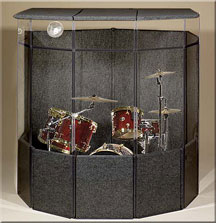Any time a band has some of its sound coming through the main PA system (usually vocals and electronic instruments) and some of the sound coming from the stage acoustically (most notably the drums) you have problems.
The drummer must play loud enough to keep up with the sound system, which he cannot hear.
However, playing loudly enough for the back row of listeners means that the drums are often too loud for the first several rows. It’s even louder on stage, which requires the rest of the band to play louder and turn up the stage monitors.
The result is a stage volume that is overwhelming – too loud for the room, and often louder than the main sound system in the room, and still unclear.
People get frustrated and irritable, and some leave to find another church where they can understand the music.
A major part of the solution for this problem is to control the sound of the on-stage instruments, beginning with the drums.
There are three steps in controlling drums in church:
1. Contain the acoustic energy from the drums
2. Absorb the acoustic energy from the drums
3. Reinforce the sound that you want from the drums and provide monitoring back to the drummer
Containing the acoustic energy from the drums is the easiest part. The sound of the drums travels from the drum head to the ears of the people hearing it.
The strongest part of that sound is generally direct line-of-sight.Many churches have installed plexiglass drum shields around the drums for this purpose. It’s cost-effective and it’s a reasonably effective starting point.
The plexiglass reflects most sound, preventing the direct line-of-sight sound from reaching the people in the congregation.
This solves one problem and introduces a couple of new ones.
Plexiglass does not absorb sound; virtually all of the sound created by the drums is reflected; that means that the sound is still in the room, it’s just not traveling to the listeners in a direct route.
The drummer often feels more confident now that he’s behind the plexiglass, and often times he plays harder, creating even more sound than before. Now that sound is bouncing around the room as reflected sound.
Reflected sound is, by definition, noise: it has the same amount of energy as direct sound, but because it is reflected, it has become “incoherent.” Now instead of hearing the clear “slap” of the snare from a single source, we hear reflections of that slap from various reflective surfaces around the room.
The clarity is decreased, but the energy of the snare is still there, rattling around the room, muddying up the rest of the sound.





















